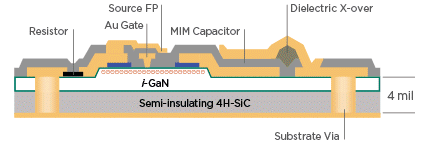RF Foundry

MACOM's Foundry Services Team Helps Bring Your Designs to Production
- Mature 100-mm GaN production line
- RF MMIC on-wafer probe / dice
- Automatic Optical Inspection (AOI)
- Foundry applications support
GaN Foundry Services
MACOM’s RF foundry services team turns designs into reality. We have the design assistance, testing capability and support to realize your specifications from initial development to recurring production.
Shared GaN Foundry Wafers
MACOM offers shared mask service with reduced cost and MMIC size, providing multiple customers the opportunity to get their MMIC designs fabricated faster.
| Applications | Service Features | Circuit Types |
|---|---|---|
|
5G infrastructure |
AWR Design Environment (Microwave Office) and Keysight Technologies’ ADS process design kits |
High-power FET amplifiers |
|
Satellite communications |
Layout support and DRC |
Broadband amplifiers |
|
Ultra-wide band EW |
Development lots in dedicated and shared mask options |
High-efficiency amplifiers |
|
Two-way private radio |
Electrical test services available |
High IP3 amplifiers |
|
Test instrumentation |
Visual screening |
Multi-function integrated MMICs |
|
Broadband amplifiers |
FET limiters |
|
|
EW jammers |
|
High-power FET switches |
|
Class A, AB, linear amplifiers suitable with OFDM, QPSK, QAM, FM waveforms |
High-IP3 FET mixers |
|
|
Radar |
Attenuators |
|
|
Military communications |
Phase shifters |
|
|
Low-noise amplifiers |
Foundry Engagement Options
MACOM offers two foundry service options for GaN die design:
- Customer creates design and layout. Completed artwork is submitted to MACOM for fabrication.
- Customer engages MACOM design services to create custom die design and layout per customer specifications.
GaN HEMT MMIC Processes
Processes
| G28V5 | G28V4 | G40V4 | G28V3 | G50V3 | G50V4 | |
|---|---|---|---|---|---|---|
| Gate Length | 0.15µm | 0.25µm | 0.25µm | 0.4µm | 0.4µm | 0.25µm |
| Bias Voltage | 28V | 28V | 40V | 28V | 50V | 50V |
| Breakdown Voltage | >84V | >84V | >120V | >84V | >150V | >150V |
| RF Density | 3.75W/mm | 4.5W/mm | 6W/mm | 4.5W/mm | 8W/mm | 8.5W/mm |
| Frequency Band | DC - 40GHz | DC - 18GHz | DC - 18GHz | DC - 8GHz | DC - 6GHz | DC - 18GHz |
| SiC Substrate thickness | 75µm | 100µm | 100µm | 100µm | 100µm | 100µm |
| Fact Sheet |
Product Design Kits (PDKs) and Models
- Scalable non-linear model
- Passives created with MACOM design rules
- Full schematic-driven layout
- Real time design rule-checking
MACOM offers non-linear, scalable GaN HEMT models for MMICs, as well as full PDKs for Keysight Technologies’ Advanced Design System (ADS) and Cadence/AWR Microwave Office (MWO).
GaN Foundry Dedicated Wafers
MACOM fabricates a fully custom wafer run containing the customer’s exclusive die designs. The entire reticle is available for the customer MMIC or discrete device content. Diced, PCM-good wafers are delivered.
- Custom designs
- DRC, layout, and model support
- DC/RF on-wafer testing services optional
- Die pick and place to gel pack available
- Plastic overmold packaging services available for select lead frames
Trusted Foundry
MACOM is a DMEA Certified Trusted Foundry.
MACOM’s GaN foundry services are executed in a Defense Microelectronics Activity (DMEA) certified Category 1A trusted-foundry. We have manufacturing and statistical process controls in place to enable quick and reliable turnaround times.
Foundry Training
MACOM offers in-depth training for RF Microwave engineers who want to learn how to design in the MACOM FAB. Basic knowledge of MMIC design and experience using Microwave Office (MWO) or Advanced Design System (ADS) is required.
This training will offer RF Microwave engineers the opportunity to:
- Learn how to best utilize the PDK
- Explore HEMT and passive device models
- Understand the proper steps in designing a MMIC or HEMT
- Follow proper procedures for submitting a design
